Abstract
Contractile properties of soleus muscles isolated from 31 euthyroid (EU), 20 hyperthyroid (HT), and 18 myxedematous (MY) rats were studied in a myograph. At 100 stimuli/sec maximum isometric tension was essentially identical in EU (17.2 ±0.5 g/mm2) and HT (17.7 ±0.5 g/mm2) muscles, but was significantly depressed in MY muscles (11.5 ±0.7 g/mm2). The rate of tension development was increased in HT (103 ±4.5 g/sec per mm2) as compared to both EU (86.2 ±4.6 g/sec per mm2) and MY (38.4 ±2.2 g/sec per mm2) muscles, while the duration of the active state was shortened in HT (77.1 ±2.3 msec) as compared to EU (105.1 ±1.1 msec) muscles and was prolonged in MY muscles (153.3 ±6.0 msec). The mean rate of isometric relaxation was 26.5 ±4.9 g/mm2 per sec in EU muscles, more rapid in HT muscles (33.1 ±1.3 g/sec per mm2), and slower in MY muscles (16.0 ± g/mm2 per sec). The fusion frequency was greater in HT muscles, averaging 68.5 ±3.6 stimuli/sec compared to EU muscles (38.1 ±1.2 stimuli/sec) and to MY muscles (33.3 ±4.0 stimuli/sec). At 40 stimuli/sec tension averaged 16.4 ±0.8 g/mm2 in EU muscles while at the same frequency tension was reduced in HT muscle, averaging 14.2 ±0.5 g/mm2. All differences were significant (P < 0.01). In conclusion, HT and MY result in profound alterations in the intrinsic contractile properties of skeletal muscle. While tension in HT muscles is maintained in vitro at a stimulus frequency of 100 stimuli/sec, the reduction in duration of active state may lower tension in vivo by preventing complete fusion of contractile events. In MY tension is reduced as a consequence of the lowered intensity of the active state. These changes explain, at least in part, the weakness of muscle activity in both HT and MY.
Full text
PDF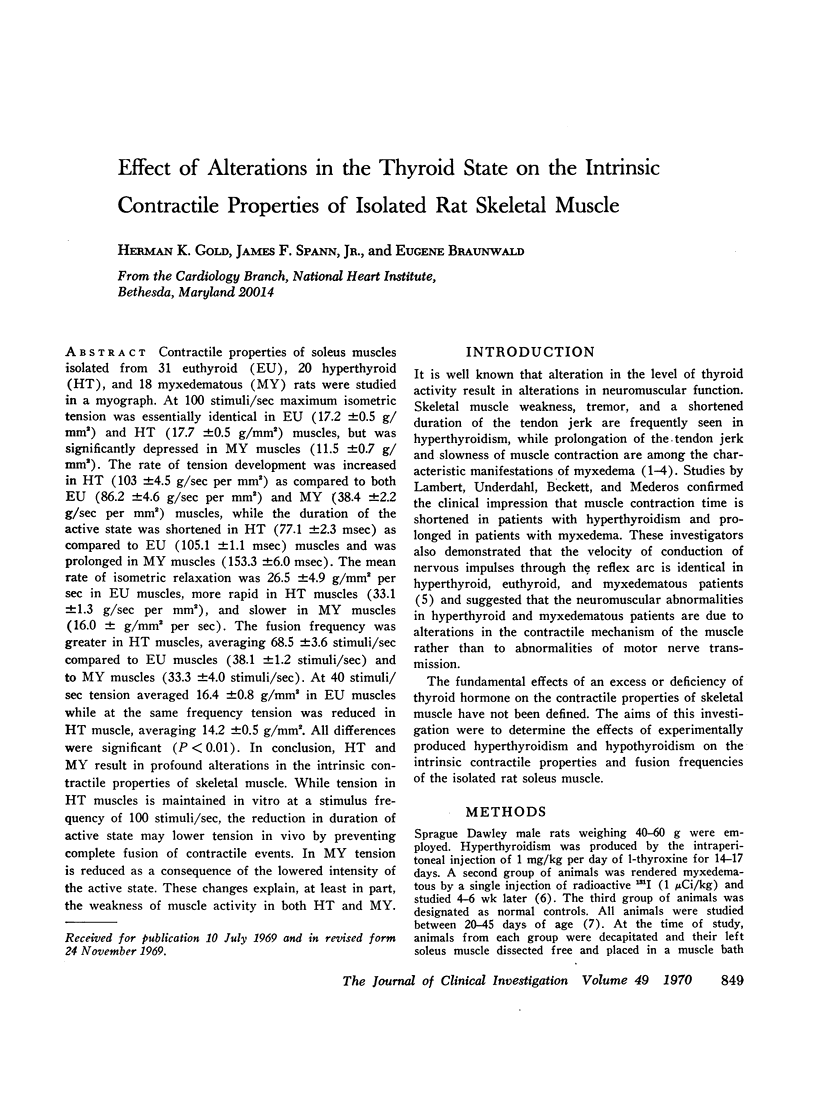
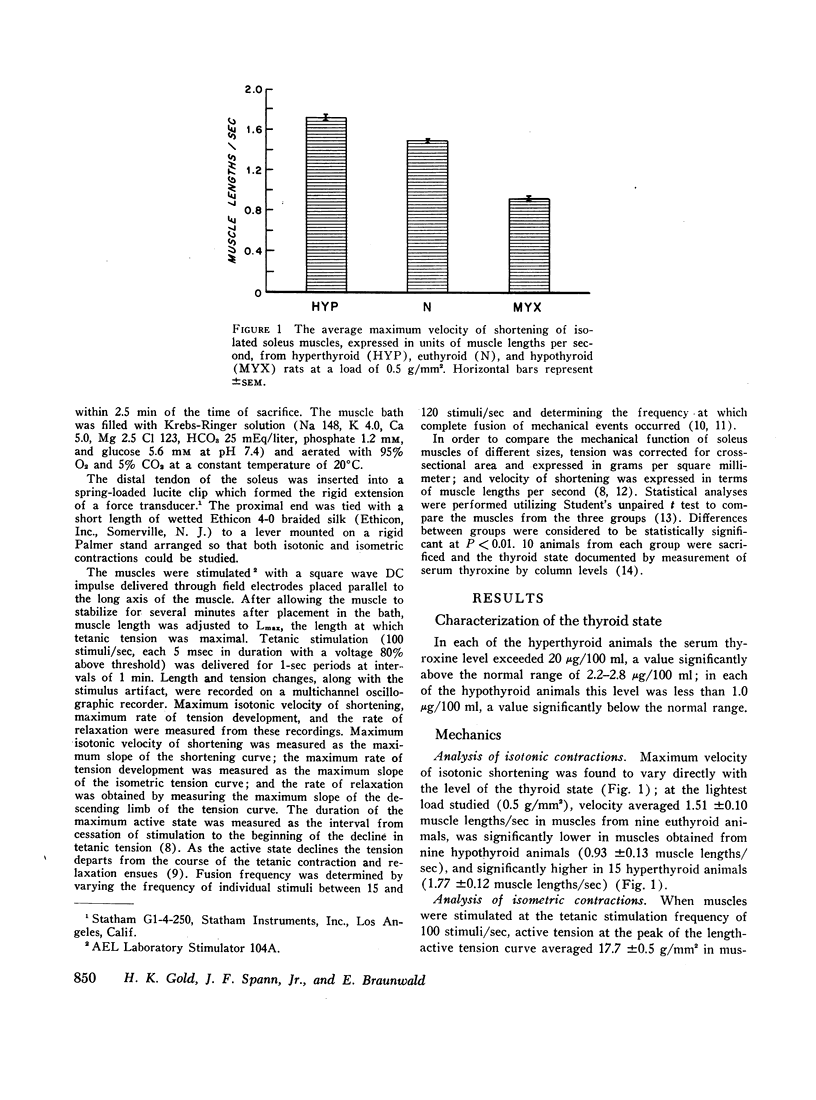
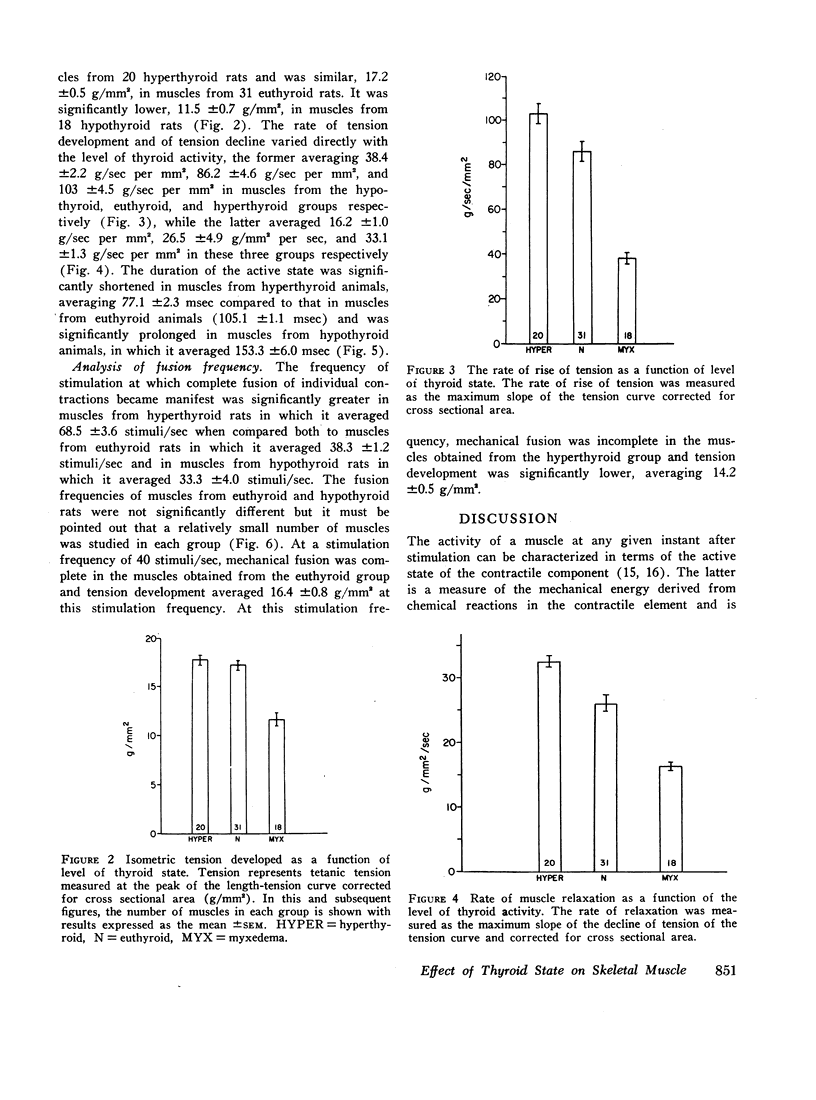
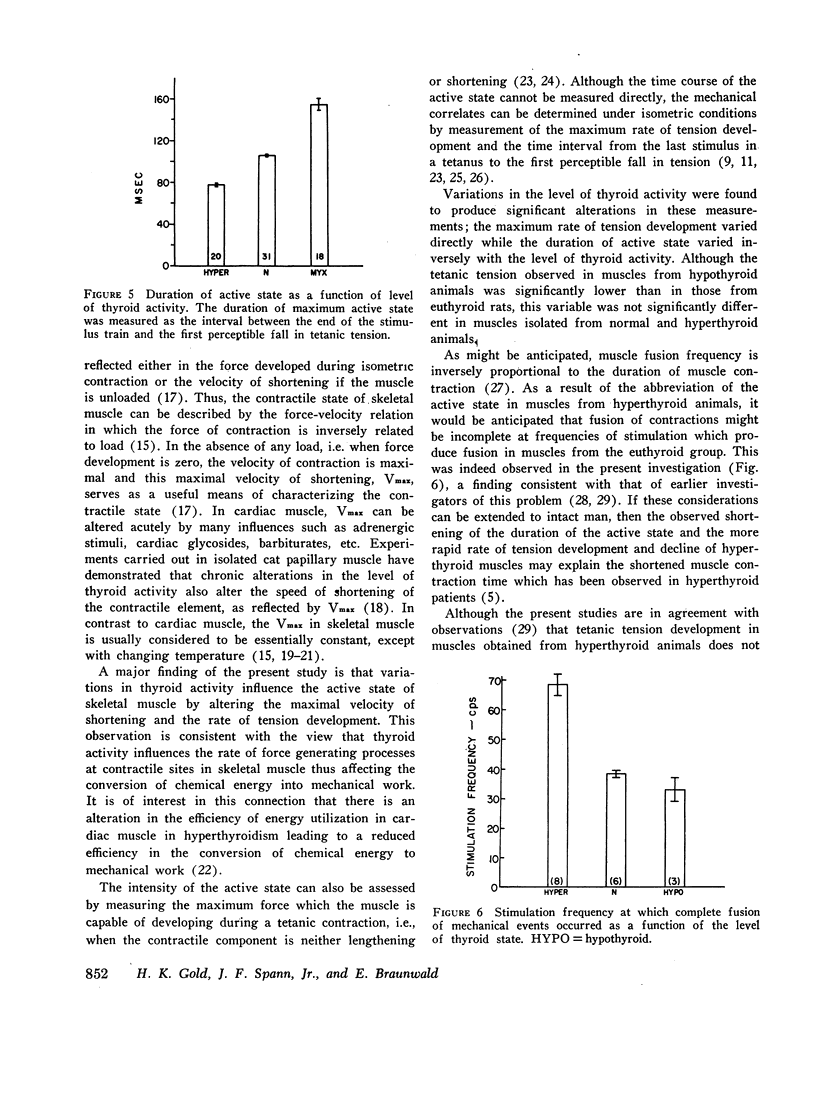
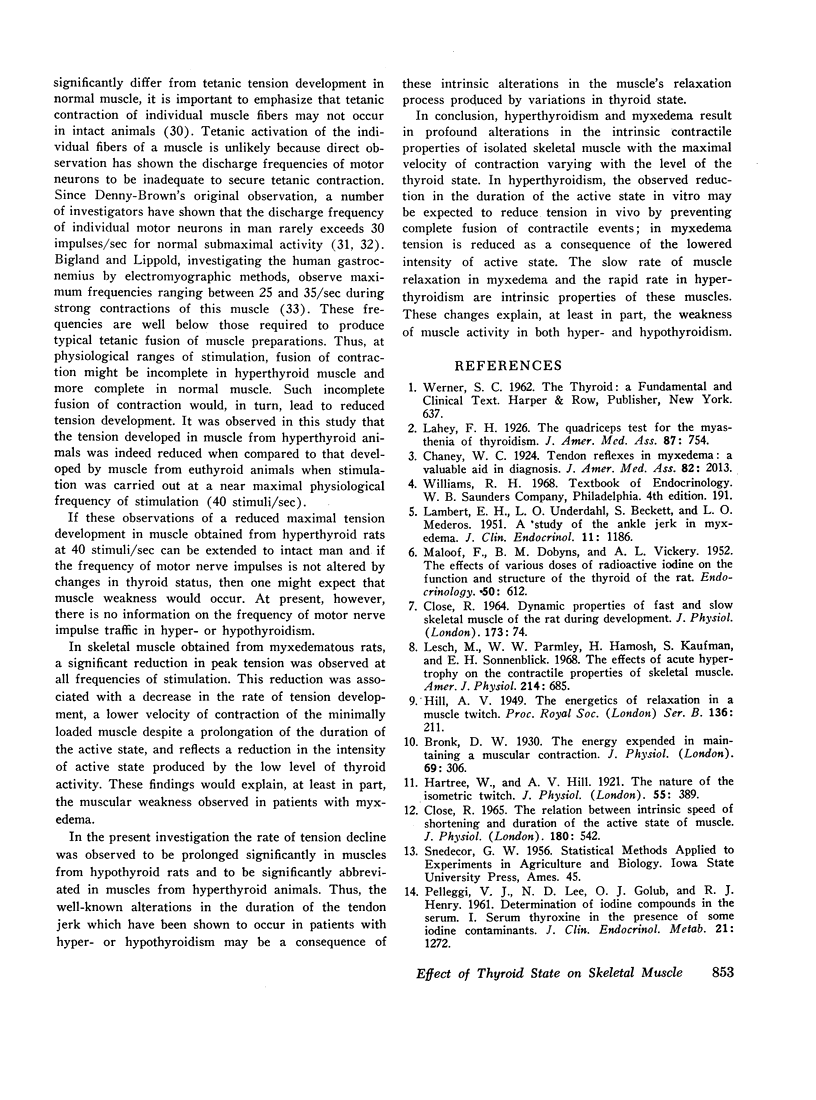
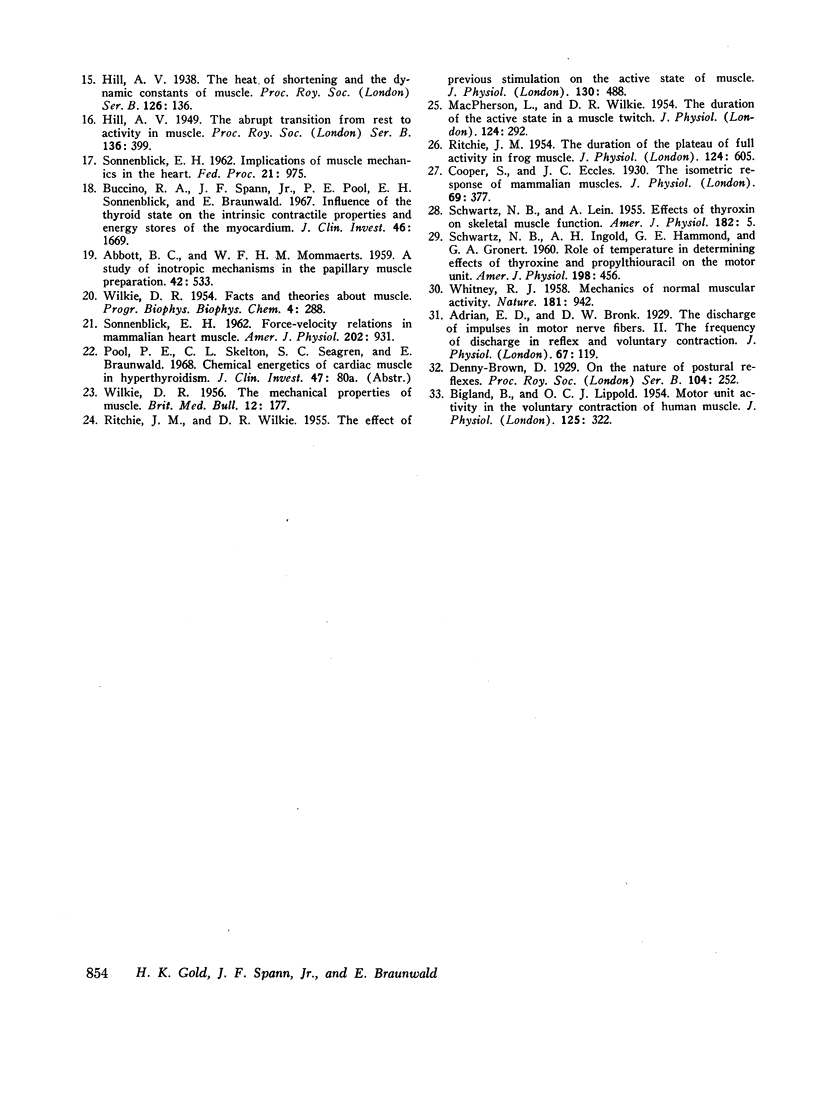
Selected References
These references are in PubMed. This may not be the complete list of references from this article.
- ABBOTT B. C., MOMMAERTS W. F. A study of inotropic mechanisms in the papillary muscle preparation. J Gen Physiol. 1959 Jan 20;42(3):533–551. doi: 10.1085/jgp.42.3.533. [DOI] [PMC free article] [PubMed] [Google Scholar]
- BIGLAND B., LIPPOLD O. C. Motor unit activity in the voluntary contraction of human muscle. J Physiol. 1954 Aug 27;125(2):322–335. doi: 10.1113/jphysiol.1954.sp005161. [DOI] [PMC free article] [PubMed] [Google Scholar]
- Bronk D. W. The energy expended in maintaining a muscular contraction. J Physiol. 1930 May 31;69(3):306–315. doi: 10.1113/jphysiol.1930.sp002650. [DOI] [PMC free article] [PubMed] [Google Scholar]
- Buccino R. A., Spann J. F., Jr, Pool P. E., Sonnenblick E. H., Braunwald E. Influence of the thyroid state on the intrinsic contractile properties and energy stores of the myocardium. J Clin Invest. 1967 Oct;46(10):1669–1682. doi: 10.1172/JCI105658. [DOI] [PMC free article] [PubMed] [Google Scholar]
- Close R. The relation between intrinsic speed of shortening and duration of the active state of muscle. J Physiol. 1965 Oct;180(3):542–559. doi: 10.1113/jphysiol.1965.sp007716. [DOI] [PMC free article] [PubMed] [Google Scholar]
- Cooper S. The isometric responses of mammalian muscles. J Physiol. 1930 Jun 27;69(4):377–385. doi: 10.1113/jphysiol.1930.sp002657. [DOI] [PMC free article] [PubMed] [Google Scholar]
- Hartree W., Hill A. V. The nature of the isometric twitch. J Physiol. 1921 Nov 18;55(5-6):389–411. doi: 10.1113/jphysiol.1921.sp001984. [DOI] [PMC free article] [PubMed] [Google Scholar]
- LAMBERT E. H., UNDERDAHL L. O., BECKETT S., MEDEROS L. O. A study of the ankle jerk in myxedema. J Clin Endocrinol Metab. 1951 Oct;11(10):1186–1205. doi: 10.1210/jcem-11-10-1186. [DOI] [PubMed] [Google Scholar]
- Lesch M., Parmley W. W., Hamosh M., Kaufman S., Sonnenblick E. H. Effects of acute hypertrophy on the contractile properties of skeletal muscle. Am J Physiol. 1968 Apr;214(4):685–690. doi: 10.1152/ajplegacy.1968.214.4.685. [DOI] [PubMed] [Google Scholar]
- MACPHERSON L., WILKIE D. R. The duration of the active state in a muscle twitch. J Physiol. 1954 May 28;124(2):292–299. doi: 10.1113/jphysiol.1954.sp005107. [DOI] [PMC free article] [PubMed] [Google Scholar]
- MALOOF F., DOBYNS B. M., VICKERY A. L. The effects of various doses of radioactive iodine on the function and structure of the thyroid of the rat. Endocrinology. 1952 Jun;50(6):612–638. doi: 10.1210/endo-50-6-612. [DOI] [PubMed] [Google Scholar]
- PILEGGI V. J., LEE N. D., GOLUB O. J., HENRY R. J. Determination of iodine compounds in serum. I. Serum thyroxine in the presence of some iodine contaminants. J Clin Endocrinol Metab. 1961 Oct;21:1272–1279. doi: 10.1210/jcem-21-10-1272. [DOI] [PubMed] [Google Scholar]
- RITCHIE J. M., WILKIE D. R. The effect of previous stimulation on the active state of muscle. J Physiol. 1955 Nov 28;130(2):488–496. doi: 10.1113/jphysiol.1955.sp005422. [DOI] [PMC free article] [PubMed] [Google Scholar]
- SCHWARTZ N. B., INGOLD A. H., HAMMOND G. E., GRONERT G. A. Role of temperature in determining effects of thyroxine and propylthiouracil on the motor unit. Am J Physiol. 1960 Feb;198:456–462. doi: 10.1152/ajplegacy.1960.198.2.456. [DOI] [PubMed] [Google Scholar]
- SCHWARTZ N. B., LEIN A. Effects of thyroxin on skeletal muscle function. Am J Physiol. 1955 Jul;182(1):5–11. doi: 10.1152/ajplegacy.1955.182.1.5. [DOI] [PubMed] [Google Scholar]
- SONNENBLICK E. H. Force-velocity relations in mammalian heart muscle. Am J Physiol. 1962 May;202:931–939. doi: 10.1152/ajplegacy.1962.202.5.931. [DOI] [PubMed] [Google Scholar]
- SONNENBLICK E. H. Implications of muscle mechanics in the heart. Fed Proc. 1962 Nov-Dec;21:975–990. [PubMed] [Google Scholar]
- WHITNEY R. J. Mechanics of normal muscular activity. Nature. 1958 Apr 5;181(4614):942–944. doi: 10.1038/181942a0. [DOI] [PubMed] [Google Scholar]
- WILKIE D. R. The mechanical properties of muscle. Br Med Bull. 1956 Sep;12(3):177–182. doi: 10.1093/oxfordjournals.bmb.a069546. [DOI] [PubMed] [Google Scholar]


